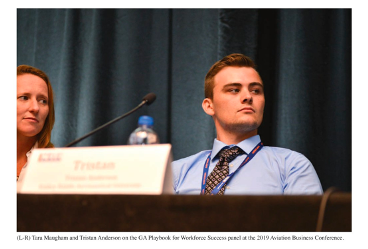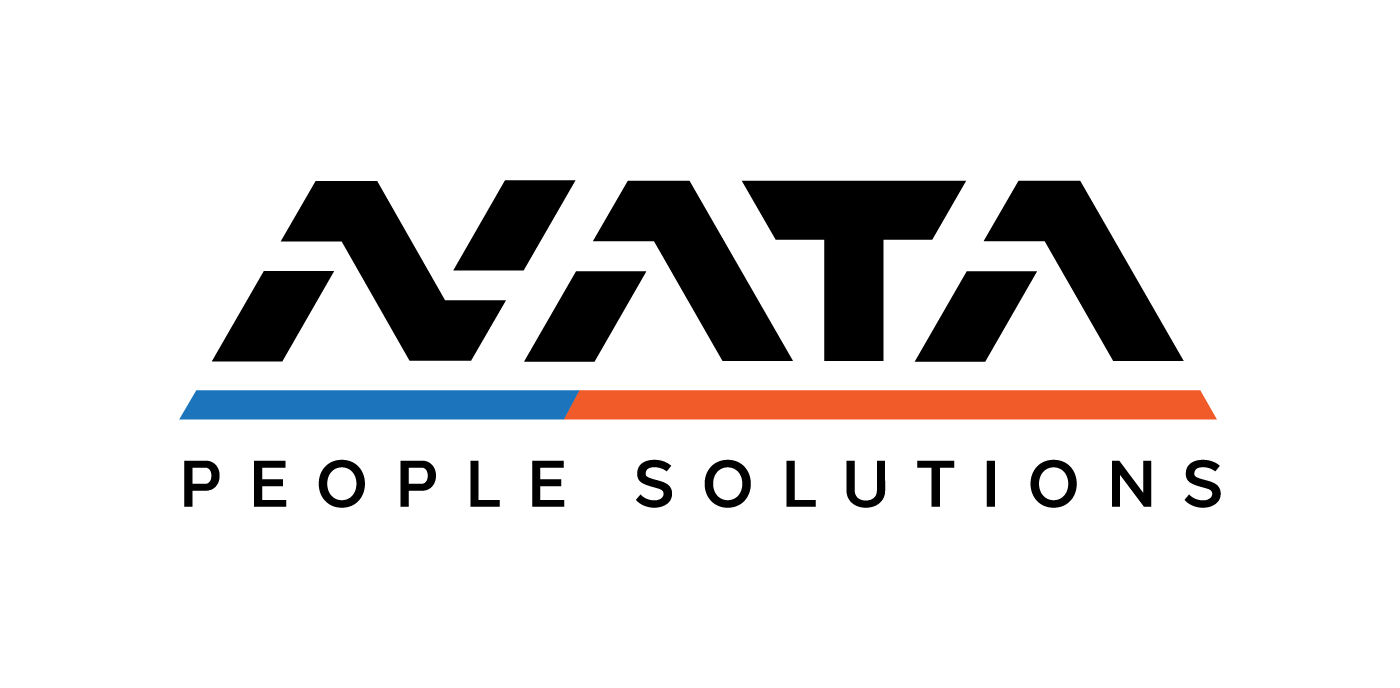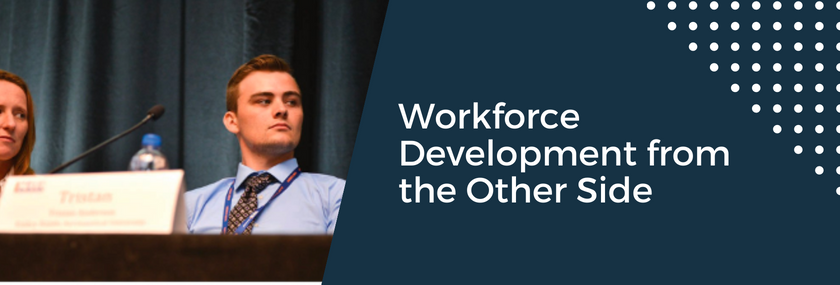Workforce Development from the Other Side: Job-Seeking Students Participate in Aviation Business Panel Discussion
Two students attended the Aviation Business Conference in June, participating in a Workforce Development panel discussion, networking with NATA members, and providing insight into the needs of the current generation of aviation job-seekers.
Tristan Anderson, an Aviation Maintenance Science student at Embry-Riddle Aeronautical University, was sponsored by Naples Airport Authority and spoke on the panel. Tomas Pacheco, a 2019 graduate from the University of Dubuque’s Aviation Management program, was sponsored by NATA. It was the first visit to Washington, D.C. for both students.
“Attending the Aviation Business Conference introduced me to all these companies that are working hard to reach out, to build their teams, and to help people coming into the industry build their careers,” said Pacheco, who recently completed an internship at Dubuque Regional Airport in Iowa. “It was eye-opening, as a jobseeker, to see from the other side that this is an industry that is very much concerned about a commercial pilot shortage and about challenges with filling skilled positions at every level. I met a lot of people at the conference who sincerely want to help students out, asking ‘How are we going to get younger audiences to want to be pilots and to want to be in all the different roles available in this industry?’ and I just kept saying, ‘Trust me, the people are out there.’”
Pacheco completed his Bachelor of Science in Aviation Management in Spring 2019. He says his trip to the Aviation Business Conference inspired him to resume his pilot training in January 2020.
“I had put my pilot training on hold while I focused on graduating from school because I couldn’t afford to finish it at the time,” said Pacheco. “Then, hearing all about the pilot shortage and meeting all of these people at the NATA conference, from companies looking to hire pilots, made me feel like I can’t afford not to finish it. I had an amazing time: it was very informative and great to be a part of everything.”
Ryan Waguespack, Vice President of NATA and a former chair of its Workforce Development Committee, first met Pacheco while touring aviation programs at universities across the country. Waguespack has been addressing students about opportunities in aviation business and conducting mock interviews and workshops, helping students understand some of the things NATA member companies look for when hiring students.
“I’ve been going out and highlighting opportunities in our industry,” Waguespack said. “We want to get the message out to the next generation that our industry is hiring and get them exposed to seeing themselves in our industry by getting NATA and our members out into the markets—the universities, two-year college programs, and technical high schools—to showcase all of the many available career paths in aviation business. The goal is to show the next generation that there are great opportunities, that you can build a career in this industry, and there are many paths such a career might take.”
Some priorities of the Workforce Development Committee include developing a more robust jobs list and expanding outreach to college programs.
“To really do workforce development right, in my opinion, is to do it as a regional, organic, and grassroots effort,” he said. “Pilots, technicians, and other skilled people coming into our industry are going to go wherever the money and the quality of life are, so it’s really a matter of exposing them to the tremendous growth opportunities we can offer. The NATA Workforce Development Committee has been wrangling with some of those big questions: ‘Where’s the next generation pipeline?’ ‘What’s our recruitment and retention plan?’ Train, empower, and retain have been our buzzwords, because you can’t just throw these young college grads or high school grads into environments that they’ve never had any understanding of, setting them up to fail and not providing the proper tools. We have to make it a priority to find these people, train these people, and give them opportunities to grow and stay with our companies.”

Inviting Pacheco and Anderson to the Workforce Development panel was as much about educating NATA members as it was about creating networking opportunities for impressive young students.
“As I was meeting with Tomas, Tristan, and other students, I realized that there was also an opportunity to bring their voices to our conference as panelists in front of our membership, to describe their needs, because there truly have been some generational shifts and they were able to share some of that in the panel discussion,” Waguespack said. “This generation of job-seekers isn’t necessarily driven by needing astronomical pay, as an example. “They’ll tell you that they’re more interested in quality of life and work-life balance. And, they want to see paths to upward mobility: ‘I’ll start here, but what’s next?’ Business aviation can be great avenues on both fronts, but it’s important for our members who are hiring and recruiting to understand those motivations. The leaders in our member companies today have grown in the aviation business through the hard knocks – it was a hard crawl to get where I am – and this younger generation is just as motivated, but now there are opportunities all over the place. So, it’s a learning curve for us, too. We have to figure this out because it is and is going to continue to be a real competition to attract this next generation.”
Tristan Anderson is currently a senior, finishing up his Bachelor of Science degree in Aviation Maintenance Science at Embry-Riddle Aeronautical University in Daytona, FL, and also working on completing his pilot training. His trip to the Aviation Business Conference was his first visit to Washington, D.C., his first time meeting a Senator—he spent some time with freshman Senator Rick Scott (R-FL) during the trip, and, his first time even learning of the existence of many NATA member companies.
“In school I really hadn’t learned about opportunities in business aviation, because a lot of the focus is on the commercial airlines, and probably the single biggest surprise of my trip was discovering that there are literally thousands of member companies in NATA and many of them are looking to hire,” Anderson said. “The majority of the companies I was exposed to at the NATA conference are hiring, and I collected so many business cards. I’d never been to anything like that before.”
Anderson, who currently works as a technician in the Embry-Riddle Repair Station as he finishes college and pilot training, said he’s trying to keep his priorities straight as he looks towards the next steps in his career.
“My priority is not just to get a job, but also find a place where I’d be happy to work for a long time,” said Anderson. “I want opportunities where I can move up and grow within a company over a long period of time. My generation has gotten a bad rap, but I would say to anyone hiring or recruiting, don’t discard or dismiss us. We aren’t lazy. We dream big, and we’re willing to work hard for it.”
Chris Rozansky, Executive Director of Naples Airport Authority in Naples, FL, and a new member of the NATA Board of Directors as of June 2019, said he was intrigued by the opportunity to sponsor Anderson’s trip to the conference.
“At Naples Airport Authority, we’re first and foremost a public entity, and then we’re also an FBO operator,” Rozansky said. “Part of our strategic plan includes a goal that we’re going to help equip future leaders coming into our industry. We saw the opportunity offered by NATA to sponsor a student and our first thought was: ‘Well, there’s some low-lying fruit!’ Tristan, the student we sponsored, really enjoyed it. The most impactful thing he said to me was, ‘Before this conference I didn’t know 80 percent of these companies even existed. It was so eyeopening.’ And it was eye-opening for me, too. It’s a good reminder that we have got to work harder to get out in front of these young people.”
“I want opportunities where I can move up and grow within a company over a long period of time. My generation has gotten a bad rap, but I would say to anyone hiring or recruiting, don’t discard or dismiss us. We aren’t lazy. We dream big, and we’re willing to work hard for it.”
Tristan Anderson
Tweet
Workforce Development In Action At Naples Airport Authority
Naples Airport Authority was the first NATA member to sponsor a student’s attendance at the Aviation Business Conference to speak on the Workforce Development panel, so the Aviation Business Journal followed up to see what other workforce development initiatives are underway at the airport and FBO, which is celebrating its 50th anniversary year in 2019.
“We have four goals outlined in our strategic plan,” said Chris Rozansky, Executive Director of Naples Airport Authority. “The first is to provide a safe, modern, and efficient airport and FBO. The second is to be an engaged, responsive partner in service to our community. The third is to strengthen the airport’s economic vitality. Finally, the fourth is to equip employees and leaders to excel today while preparing for tomorrow. A big part of that fourth goal is to inspire the next generation of aviation professionals.”
One key aspect of their workforce development efforts is a partnership with nearby Lorenzo Walker Technical High School. The school offers an Airframe & Powerplant (A&P) certificate program.
“Lorenzo Walker Technical High is essentially across the street from the airport, and it’s been a longtime partnership, since well before my arrival here three and a half years ago,” Rozansky stated. “We partner with them on a number of initiatives in addition to the A&P program, including hosting a day where students involved with student government can come and shadow our department heads and then go and create a mock board agenda. Some serve as airport staff; and some serve as board members; and we run an actual meeting to give them a sense of what it is like to govern an actual airport. We also host a Fly-In Cruise-In fundraiser every year—the eighth annual event will be held in February 2020—to fund scholarships for students to attend the A&P program at the high school, essentially helping students earn their license to launch a career as soon as they graduate from high school. This year, we raised about $30,000 for those scholarships. Over the yea we’ve had a number of Lorenzo Walker graduates come work for us at the FBO and for some of the other businesses on the airfield who do charter and aircraft maintenance and repair, so we see the direct result of those workforce development efforts almost immediately.”
Another long-term partnership is with EAA Young Eagles and the Naples Youth Aviation Project, which invites students between the ages of 10 and 18 to participate in building experimental kit aircraft under the guidance of the Naples-based EAA Chapter 1067. The airport authority provides a hangar and restroom at significantly reduced rent for the project. There are currently 25 students participating in a NYAP build.
“When you talk to people in our industry, just about everyone has a story about how they first fell in love with aviation from an early age, so when we speak of ‘workforce development,’ in my mind, it’s a mistake to focus all of that effort at the college level,” Rozansky explained. “We’ve got to find ways to inspire much younger people to dream of careers in aviation and careers with us. Even high school is late in the game – I first got into aviation through a Civil Air Patrol cadet program when I was still in middle school! We really need to be reaching students in the elementary school, middle school, or high school time frame. These kids in the Naples Youth Aviation Project, for example, they’re working alongside EAA chapter members, including pilots, mechanics, and aircraft builders and restorers. And, they’re building actual aircraft, learning all the introductory stuff about aerodynamics and mechanics, all of it. I absolutely think we’ll see a bunch of these kids pursuing pilot’s licenses, A&P certificates, and careers in our industry. And, it’s not even just the pilot shortage or the mechanic shortage that we’re talking about. These are kids raised on technology, and there are so many opportunities on the technology side in our industry right now. There are going to be lots of great careers in aviation that don’t require ever learning to fly or turn a wrench.”
* This article was originally posted in the Aviation Business Journal. Read the full article here.

